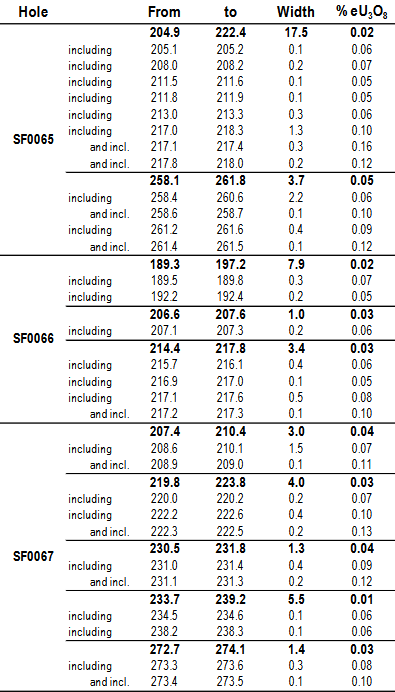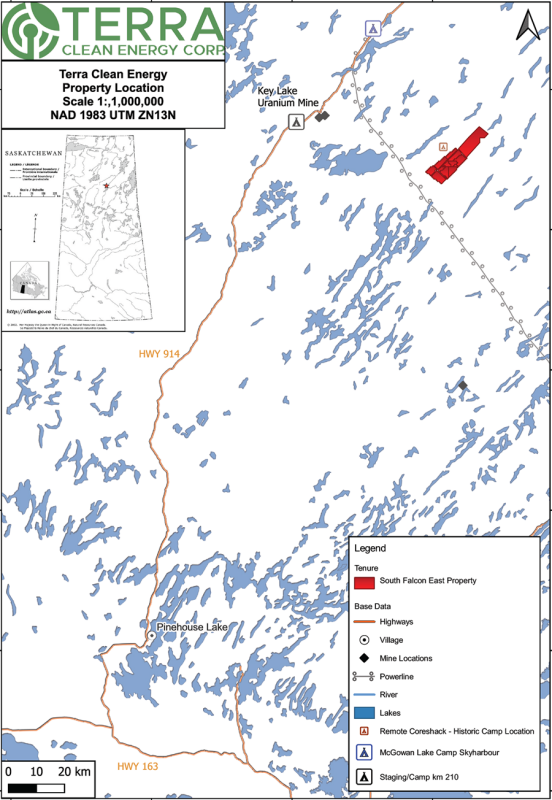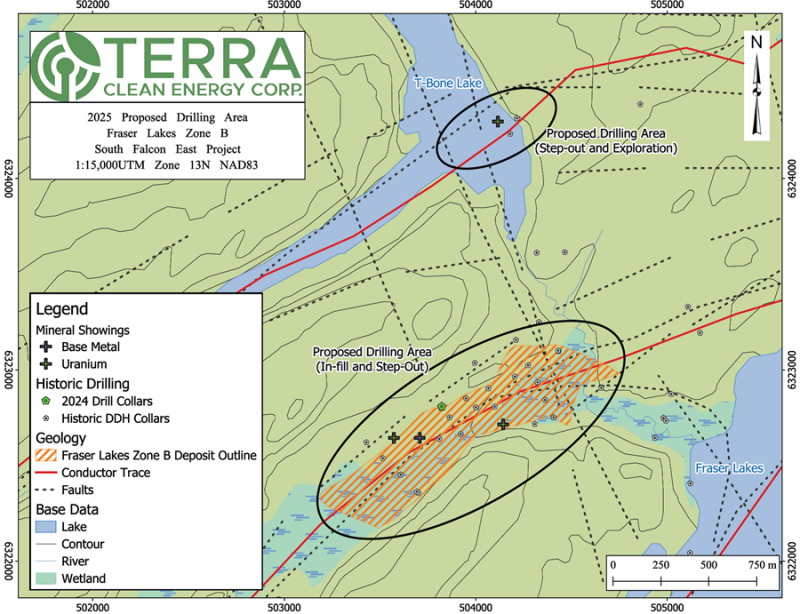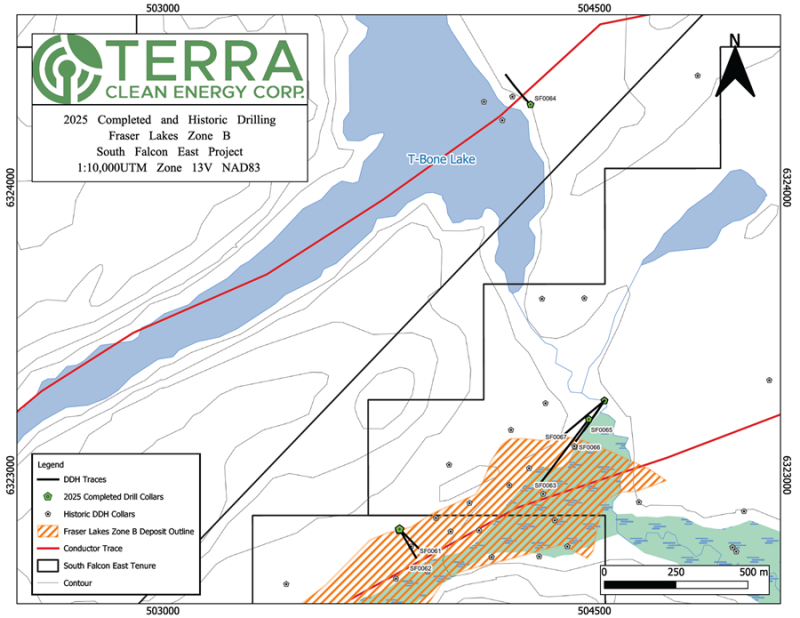Terra Clean Energy Completes Winter Drill Program With Encouraging Results; Plans Significant Summer Drill Program
- Six holes intercepted uranium mineralization
- Continuity across the deposit confirmed
- Drilling expands mineralized footprint
thenewswire.com
Vancouver B.C., April 1st, 2025 – TheNewswire - TERRA CLEAN ENERGY CORP. (“Terra” or the “Company”) (CSE: TCEC, OTCQB: TCEFF, FSE: 9O0, is pleased to announce the completion of the recent winter drill program at the South Falcon East Uranium Project (the “Property”) which hosts the Fraser Lakes B Uranium Deposit.
The Property lies 18 km outside the southeastern edge of the Athabasca Basin, Saskatchewan, approximately 50 km east of the Key Lake Uranium Mill and former mine (Figure 1). The Company entered into an option agreement with Skyharbour Resources Ltd. (“Skyharbour”) in October of 2022 whereby the company can earn up to a 75% interest in the Property (see press release dated December 30, 2024 for details of earn-in).
The Company conducted a helicopter supported drill program completing 1,927 meters in seven diamond drill holes at the Fraser Lakes B Uranium Deposit. (Figure 3) The first three drill holes were previously reported in the Company news release dated March 10, 2025.
“With uranium present in six of seven holes drilled this winter, and the east and west of the property now tied together with mineralization, this was a very successful program, and we believe we have added significant value to the Property,” said Greg Cameron CEO of Terra Clean Energy. “We are seeing wider intervals of mineralization up to 75 meters and more consistent spikes of higher-grade uranium with 0.16% reported in Hole SF0065. The Fraser Lakes Uranium Deposit is shallow in nature making it ideal for an open pit scenario being only 150 meters below surface and not far from a powerline and Cameco’s Key Lake Uranium Mill, making it a unique opportunity, especially in a rising uranium price environment. As we continue to add pounds of uranium and higher grades, this deposit becomes more and more valuable.”
Hole SF0065 was drilled to follow up the results of SF0063, reported in the March 10 news release. It was targeted to intersect the same mineralized pegmatites 60 m to the northeast. The hole was completed to a depth of 282 m and intersected a 75 m wide zone of variably mineralized granitic pegmatites and zones within altered and graphitic pelitic gneiss. A summary of the major zones within this mineralization are shown in Table 1 with the main highlight being an equivalent grade of 0.02% eU3O8 over 17.5 m from 204.9 to 222.4 m, including 0.16% eU3O8 over 0.3 m. A zone of clay alteration and bleaching was intersected from 59 m to 68 m. The presence of this alteration is a good indication that hydrothermal fluids suitable for deposition of higher-grade uranium deposits moved through the rocks.
Hole SF0066 was drilled to a depth of 302 m, to follow the clay alteration and mineralized pegmatites to the northwest and assist in characterizing orientation of the clay alteration and associated structure. Drilling intersected a 50 m interval containing multiple mineralized granitic pegmatites and zones within altered and graphitic pelitic gneiss. The most notable zone returned an equivalent grade of 0.03% eU3O8 over 3.4 m from 214.4 to 217.8 m, including 0.1% eU3O8 over 0.1 m. The zone of strong clay alteration and bleaching was intersected from 57.5 m to 67.5 m. Based on oriented core data and intersections on three holes, this alteration package appears to be dipping to the north.
Hole SF0067 was drilled to a depth of 302 m, to extend the mineralized pegmatite package to the north and confirm the interpreted north dipping orientation of the clay alteration. Drilling intersected a 70 m interval containing multiple mineralized granitic pegmatites and zones within the altered and graphitic pelitic gneiss package. This interval is noted for the larger number of higher-grade spikes at or above 0.1% eU3O8 intersected compared to the previous drilling in this program. Down-hole gamma logging returned equivalent grades of 0.03% eU3O8 over 4.0 m from 219.8 to 223.8 m, including 0.13% eU3O8 over 0.2 m and 0.01% eU3O8 over 5.5 m from 233.7 to 239.2 m, including 0.06% eU3O8 over 0.2 m in the two widest intervals. The zone of strong clay alteration and bleaching was intersected from 66.5 m to 73.5 m. Drilling has now extended the deposit to the north and northeast and is still open in this direction. It is interpreted that the clay altered structural zone identified in SF0063, SF0065, SF0066 and SF067 is dipping to the north and will intersect the mineralized and hematite altered graphitic pelitic gneiss and pegmatites approximately 120 to 150 m north of the current drilling. A follow-up drill program is currently being planned to test this upgraded target area for a higher-grade unconformity related basement hosted uranium deposit and additional mineralized pegmatites where these structures and alteration all intersect.
“I’m very excited to announce we will be conducting a summer drilling program to immediately follow up on the significant results received. We believe we have started to define a new structure on the northeast side of the Property and are hopeful a basement hosted unconformity uranium deposit, similar to Eagle Point and Rough Rider, is present. Our strategy moving forward is to both increase the size and grade of the Fraser Lakes B deposit and to add additional discovery to this historical resource,” said Mr. Cameron.
”The results from this drilling program are very encouraging. Drilling has shown that the deposit is still open down dip to the northwest, north and northeast,” commented Trevor Perkins, Vice President of Exploration for the Company. “The presence of clay alteration within a structure on the northeast side has upgraded this area. Where this clay alteration intersects the mineralized conductive package is an exciting target as this can bring together many of the key features associated with the known basement hosted unconformity deposits in the basin”, continued Mr. Perkins.
One hole, SF0064, was completed to 239 m in the T-Bone Lake area to examine the conductive package and alteration intersected in the area in historical drilling. An extensive package of graphitic metasediments was intersected in this area, characterizing the conductive package. Weak alteration was noted, however no elevated radioactivity was identified. The optimal target in the T-Bone Lake area was not intersected.
Samples of the mineralized intervals within the drill core have been collected and shipped for analysis at the Geoanalytical Laboratory at the Saskatchewan Research Council in Saskatoon, Saskatchewan. Results are expected in early May. The Company will provide more detailed results once geochemical analysis of the collected core samples is completed, reviewed and confirmed.

Table 1: Mineralized intersections in final three holes at South Falcon East Uranium Project

Click Image To View Full Size
Figure 1: South Falcon East Uranium Project Location – Eastern Athabasca Basin, Saskatchewan, Canada

Click Image To View Full Size
Figure 2: 2025 Drill Target areas at the South Falcon East Uranium Project

Click Image To View Full Size
Figure 3: 2025 - Completed drill holes at South Falcon East Uranium Project
QA/QC, Radiometric Equivalent Grades and Spectrometer Readings:
All drill intervals above are downhole length and sampling procedures and QA/QC protocols for geochemical results as well as a description of downhole gamma probe grade calculations and protocols are below. All drill core samples are shipped to the Saskatchewan Research Council Geoanalytical Laboratories (“SRC”) in Saskatoon, Saskatchewan under the care of Terra personnel for preparation, processing, and multi-element analysis by ICP-MS and ICP-OES using total (HF:NHO3:HClO4) and partial digestion (HNO3:HCl), boron by fusion, and U3O8 wt% assay by ICP-OES using higher grade standards. Assay samples are chosen based on visual inspection, downhole probing radiometric equivalent uranium grades, and scintillometer (Radiation Solutions RS-125) peaks. Assay sample intervals comprise 0.5 to 1.0 m continuous half-core split samples over the mineralized interval. These samples may also be selected for density determination using the lost wax method. With all assay samples, one half of the split sample is retained and the other sent to the SRC for analysis. SRC is an ISO/IEC 17025/2005 and Standards Council of Canada certified analytical laboratory. Blanks, standard reference materials, and repeats are inserted into the sample stream at regular intervals by Terra and SRC in accordance with Terra’s quality assurance/quality control (QA/QC) procedures. Geochemical assay data are subject to verification procedures by qualified persons employed by Terra prior to disclosure.
During active exploration programs, drillholes are radiometrically logged using calibrated downhole Mount Sopris 40TGU or 2GHF probes of varying sensitivities which collect continuous readings along the length of the drillhole. Preliminary radiometric equivalent uranium grades (“eU3O8”) are then calculated from the downhole radiometric results. The probe is calibrated using an algorithm calculated from the calibration of the probe at the SRC facility in Saskatoon and from the comparison of probe results against geochemical analyses. In the case where core recovery within a mineralized intersection is poor or non-existent, radiometric grades are considered to be more representative of the mineralized intersection and may be reported in the place of assay grades. Radiometric equivalent probe results are subject to verification procedures by qualified persons employed by Terra prior to disclosure.
About Terra Clean Energy Corp.
Terra Clean Energy Corp. (formerly Tisdale Clean Energy Corp) is a Canadian-based uranium exploration and development company. The Company is currently developing the South Falcon East uranium project, which holds a historical 6.96M pound inferred uranium resource* within the Fraser Lakes B Uranium Deposit, located in the Athabasca Basin region, Saskatchewan, Canada.
ON BEHALF OF THE BOARD OF TERRA CLEAN ENERGY CORP.
“Greg Cameron”
Greg Cameron, CEO
Qualified Person
The technical information in this news release has been prepared in accordance with the Canadian regulatory requirements set out in National Instrument 43-101, reviewed and approved on behalf of the company by C. Trevor Perkins, P.Geo., the Company’s Vice President, Exploration, and a Qualified Person as defined by National Instrument 43-101.
*The historical resource is described in the Technical Report on the South Falcon East Property, filed on sedarplus.ca on February 9, 2023. The Company is not treating the resource as current and has not completed sufficient work to classify the resource as a current mineral resource. While the Company is not treating the historical resource as current, it does believe the work conducted is reliable and the information may be of assistance to readers.
Forward-Looking Information
This news release contains forward-looking information which is not comprised of historical facts. Forward-looking information is characterized by words such as “plan”, “expect”, “project”, “intend”, “believe”, “anticipate”, “estimate” and other similar words, or statements that certain events or conditions “may” or “will” occur. Forward-looking information involves risks, uncertainties and other factors that could cause actual events, results, and opportunities to differ materially from those expressed or implied by such forward-looking information, including statements regarding the potential development of mineral resources and mineral reserves which may or may not occur. Factors that could cause actual results to differ materially from such forward-looking information include, but are not limited to, changes in the state of equity and debt markets, fluctuations in commodity prices, delays in obtaining required regulatory or governmental approvals, and general economic and political conditions. Forward-looking information in this news release is based on the opinions and assumptions of management considered reasonable as of the date hereof, including that all necessary approvals, including governmental and regulatory approvals will be received as and when expected. Although the Company believes that the assumptions and factors used in preparing the forward-looking information in this news release are reasonable, undue reliance should not be placed on such information. The Company disclaims any intention or obligation to update or revise any forward-looking information, whether because of new information, future events or otherwise, other than as required by applicable laws. For more information on the risks, uncertainties and assumptions that could cause our actual results to differ from current expectations, please refer to the Company’s public filings available under the Company’s profile at www.sedarplus.ca.
Neither the CSE nor its Regulation Services Provider (as that term is defined in the policies of the CSE) accepts responsibility for the adequacy or accuracy of this release.
For further information please contact:
Greg Cameron, CEO
info@tcec.energy
Terra Clean Energy Corp
Suite 303, 750 West Pender Street
Vancouver, BC V6C 2T7
www.tcec.energy |








